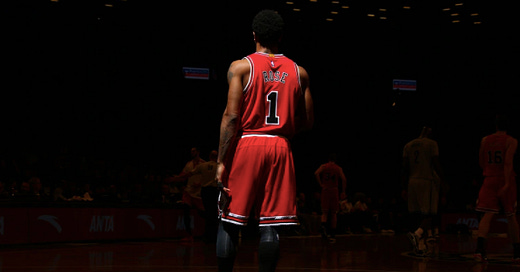Abolish the stat line
Orderly, at-a-glance numbers don’t have a place in reporting on harm, on a life exploding open.
When tackling abuse, assault, destructive acts committed by athletes we follow, support and cover for either interest, a living or pure pleasure, it can feel easy, tidier, to revert to the numbers used in decoding sports. Numbers used to describe performance, track improvement, project feats to come. Numbers that assign inherent value to a person, however right or wrong you feel about it.
The ubiquitous stat line at the end of the New York Post’s story reporting Terence Davis’s October 28th assault allegations, his average points per game, his arbitrary rank among NBA rookies in three-point percentage, is a blanket. A non-threatening swath of familiarity to pull over a story unfolding, a layer tugged tight around the shoulders of a previously held opinion as it alters, perhaps uncomfortably, for the person its happening to. The Post’s story on Kristaps Porzingis’s violent rape accusation ends with a reminder that Kevin Durant dubbed him a “unicorn” because he could shoot, make plays, defend. The blanket, then, still used to cloak, was also coddling. With Rodions Kurucs, ESPN ended their report, a paragraph just past the stark list of Kurucs’ brutal actions — choking, pushing his girlfriend onto a bed, slapping her face, biting her lip, bruising her ribs — with a laconic rebuttal by Kurucs’ attorney before the inevitable stat line came. Shot, chaser. The blanket, smothering.
There is an argument that the stat line helps to place a person. That to someone reading who did not know who Porzingis, Kurucs or Davis were, they would come away dually informed of the allegations against them as much as their profession. Of course the immediate counter to that is when reading the story, if an accompanying image didn’t do it, then wouldn’t listing the player’s current team, their position, be enough of an identifier? If you did not know who Terence Davis was, his most recent seasonal stat line was not going to help you better place him in your memory. Google’s for that.
We don’t report on other people in the public eye who commit acts of violence with a short CV of their most recent achievements. A CEO accused of criminal actions doesn’t have the revenue their company made in the last quarter revealed as proof of their professional competency, which, as in the case of athletes and their subsequent stat lines, has no bearing on criminal behaviour. The difference with athletes is a larger question of public ownership, of identifying people only by their most recent achievements and assigning worth, or likeliness of accountability, to that value. With Porzingis, Kurucs and Davis, as with Derrick Rose, Kendrick Nunn, James Johnson and Jabari Bird, the allegations came at a point in their careers where there was less notoriety around their names alone. If a superstar player was accused of any of the same things there would be no stat line needed, so the reasoning behind it being presented for these men is what? “Lesser acts” of violence? As a reporting due diligence, something to offer a full picture for the reader, it falls — as most things in pro-sports when attempting to reconcile action with accountability outside of revenue, reputation, perceived and optical value — archaically flat.
You can’t use numbers when the subject shifts wholly, violently, from sports. The entire point is to pay careful attention to what’s uncomfortable in these reports, to the already scarce details laid bare in front of you and resist math as a stabilizer or framework for recognition of the person committing acts of assault. The story should be the allegation, full-stop. The action distilled and processed by the reader who then has a choice to make on how they will move forward with the information, even privately, for themselves. There is no bearing on what came before, on how many times a person was able to sink a shot from deep, on where they spent two years of college before declaring for the draft, whether someone gave them a nickname once. These kinds of affectionate tokens are not given to their accusers, there is nothing in these sparse and painful blips that suggests what it was these women were doing when violence came screaming into their lives because, depressingly, that has never mattered. It shouldn’t matter, but it also never has. And when those details do come out — that someone was a mother, that someone was on the cusp of a breakup, that someone may have fought back — they are haphazardly stacked as detractors, as proof of something larger afoot, of liability to the accusers, in a way the cleanness of numbers never can.
The simplest explanation of the stat line as footnote is because it’s a holdover, a rule in sports reporting set down and formulaically followed. The kinds of rules we’ve collectively gotten better at examining in language no less loaded, but when it comes to the comfortable realm of sports there is still a separation, as if it were at all possible to consider the action of games and the people who play them abstract from the undercurrents and overt swells crashing down the rest of the world over.
If the stat line is needed then let it run both ways. Add footnotes for assault allegations, ongoing investigations, make it as easy to find this information as a made field goal percentage and make it as plain that these things should affect the scope and trajectory of a career in the same way poor numbers do. I say should because they don’t yet. The stat line being as much a signal to readers who know at a glance that a player is one a team is able to cut loose without a thought to their losses, another problem with quantifying worth so succinctly — it draws an over-under line to what’s passable. With Davis, who meant a lot to the Raptors in their regular season and did, still, looking ahead to where the team wanted to go, does Toronto come out with a statement of admonishment and commit money and time to women’s crisis organizations in the city if they opt to keep him? What the team’s G-League arm did in swiftly waiving Kay Felder several seasons ago, after a count of assault, was cut and dry because it could be. What was Felder to Toronto’s larger picture, just then? For all of their zero tolerance statements, this will be the only time the franchise has to align their own actions regardless of what someone like Davis’s numbers spelled for team potential. They may not even do that.
The stat line is a snapshot. A caption. A cover. These orderly, at-a-glance items don’t have a place in reporting on harm, on a life exploding open. We largely are not adept or comfortable enough yet to reconcile the two things together, the analytical order of sports with the damaging things the people playing them can do. Until we are we can at least get better when separating what is useful, what is needed and what isn’t simply mitigating one harm for the ignorance of another in how we blanket the truth.
Subscribe to BASKETBALL FEELINGS
Reconciling life with basketball, or else the other way around.










